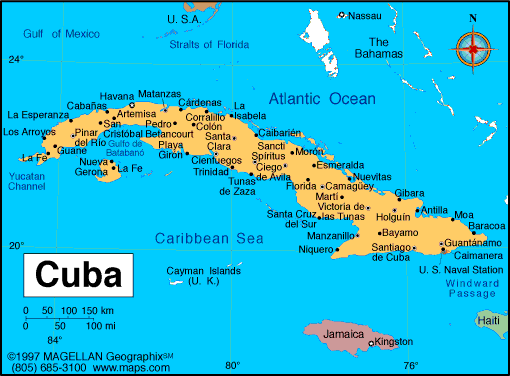CUBA

Geography: The largest island of the West Indies group (equal in area to Pennsylvania), Cuba is also the westernmost—just west of Hispaniola (Haiti and the Dominican Republic), and 90 mi (145 km) south of Key West, Fla., at the entrance to the Gulf of Mexico. The island is mountainous in the southeast and south-central area (Sierra Maestra). It is flat or rolling elsewhere. Cuba also includes numerous smaller islands, islets, and cays.
Government: Communist state.
History: Arawak (or Taino) Indians inhabiting Cuba when Columbus landed on the island in 1492 died from diseases brought by sailors and settlers. By 1511, Spaniards under Diego Velásquez had established settlements. Havana's superb harbor made it a common transit point to and from Spain.
In the early 1800s, Cuba's sugarcane industry boomed, requiring massive numbers of black slaves. A simmering independence movement turned into open warfare from 1867 to 1878. Slavery was abolished in 1886. In 1895, the poet José Marti led the struggle that finally ended Spanish rule, thanks largely to U.S. intervention in 1898 after the sinking of the battleship Maine in Havana harbor.
An 1899 treaty made Cuba an independent republic under U.S. protection. The U.S. occupation, which ended in 1902, suppressed yellow fever and brought large American investments. The 1901 Platt Amendment allowed the U.S. to intervene in Cuba's affairs, which it did four times from 1906 to 1920. Cuba terminated the amendment in 1934.
In 1933, a group of army officers, including army sergeant Fulgencio Batista, overthrew President Gerardo Machado. Batista became president in 1940, running a corrupt police state.
In 1956, Fidel Castro Ruz launched a revolution from his camp in the Sierra Maestra mountains. Castro's brother Raul and Ernesto (Ché) Guevara, an Argentine physician, were his top lieutenants. Many anti-Batista landowners supported the rebels. The U.S. ended military aid to Cuba in 1958, and on New Year's Day 1959, Batista fled into exile and Castro took over the government.

Map of Cuba
President: Raúl Castro (2008)
Total area: 42,803 sq mi (110,860 sq
km)
Population (2014 est.): 11,047,251
(growth rate: -0.14%); birth rate: 9.9/1000; infant mortality rate:
4.7/1000; life expectancy: 78.22
Capital and largest city (2011 est.):
Havana, 2.116 million
Other large cities:
Santiago de Cuba, 554,400; Camagüey, 354,400; Holguin, 319,300;
Guantánamo, 274,300; Santa Clara, 251,800
Monetary unit: Cuban Peso
National
name: República de Cuba
Language:
Spanish
National Holiday:
Triumph of the Revolution, December 10
Religions:
nominally Roman Catholic 85%, Protestant, Jehovah's Witnesses, Jewish, Santeria
Literacy rate: 99.8% (2011 est.)
Economic summary: GDP/PPP (2023 est.):
$121 billion; per capita $10,200 . Real growth rate: 3.1%.
Inflation: 6%. Unemployment: 4.3%. Arable land:
32.31%. Agriculture: sugar, tobacco, citrus, coffee, rice,
potatoes, beans; livestock. Labor force: 5.233 million; note:
state sector 72.3%, non-state sector 27.7% (2013 est.); agriculture 19.7%,
industry 17.1%, services 63.2% (2011). Industries: sugar,
petroleum, tobacco, construction, nickel, steel, cement, agricultural
machinery, pharmaceuticals. Natural resources: cobalt, nickel,
iron ore, copper, manganese, salt, timber, silica, petroleum, arable
land. Exports: $6.252 billion (2013 est.): sugar,
nickel, tobacco, fish, medical products, citrus, coffee.
Imports: $13.6 billion (2013 est.): petroleum, food,
machinery and equipment, chemicals. Major trading partners:
Netherlands, Canada, China, Spain, Venezuela, U.S., Brazil (2012).
Communications:
Telephones: main lines in use: 1.217 million (2012); mobile cellular:
1.682 million (2012). Broadcast media:
government owns and controls all broadcast media with private ownership
of electronic media prohibited; government operates 4 national TV
networks and many local TV stations; government operates 6 national
radio networks, an international station, and many local radio stations;
Radio-TV Marti is beamed from the US (2007).
Internet hosts: 3,244 (2012). Internet users: 1.606 million
note: private citizens are prohibited from buying computers or
accessing the Internet without special authorization; foreigners may
access the Internet in large hotels but are subject to firewalls; some
Cubans buy illegal passwords on the black market or take advantage of
public outlets to access limited email and the government-controlled
"intranet" (2005).
Transportation:
Railways: total: 8,203 km (2011). Roadways: total:
60,858 km; paved: 29,820 km (including 638 km of expressway); unpaved:
31,038 km (2011 est.). Waterways: 240 km (2011). Ports and
harbors: Antilla, Cienfuegos, Guantanamo, Havana, Matanzas, Mariel, Nuevitas Bay, Santiago de Cuba. Airports:
133 (2013 est.).
International
disputes: US Naval Base at Guantanamo Bay is leased to US and only
mutual agreement or US abandonment of the area can terminate the
lease.
-------------------- o --------------------
No comments:
Post a Comment